Toyota Camry
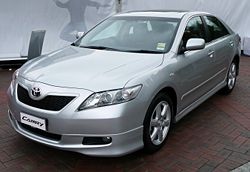 |
|
| Manufacturer | Toyota Motor Corporation |
|---|---|
| Production | 1980–present |
| Predecessor | Toyota Corona |
| Class | Compact (1980–1996) Mid-size (1996–present) |
The Toyota Camry is a mid-size car, formerly a compact car manufactured by Toyota since 1980. The name "Camry" comes from a phonetic transcription of the Japanese word kamuri (冠, かんむり), which means "crown", a tradition started with the Toyota Crown in the 1950s, and continued with the Corolla and Corona, which are also Latin words for "crown".
For the East and Southeast Asian markets, high specification Camry models are seen as executive cars. Since the sixth generation SXV30 model, the Camrys sold in these markets have sported revised front- and rear-end treatment. For the seventh generation SXV40 series, the same was done, although the Australian-designed Toyota Aurion which is based on the seventh generation Camry was the donor model. The Aurion features revised front- and rear-end treatment and changes to the interior, but is fitted with the same powertrains. An up-branded luxury version of the Camry was sold in Japan as the Toyota Windom until 2006; the related Lexus ES shares major chassis and drivetrain components with the Camry.
In the United States, the Camry has been the best selling car for nine of the last ten years starting in 1997, with the only exception being 2001. The Camry also sells very well in Australia, Canada, and a number of Asian markets—in particular Cambodia where the vast majority of cars are Camrys.[1] Despite its success, it has often been criticized for its bland design and lack of sportiness compared to its rivals.[2] It has not sold as well in Europe and its homemarket Japan; as its design is ill-suited for European and Japanese tastes.[3]
Celica Camry (A40, A50) (1980–1982)
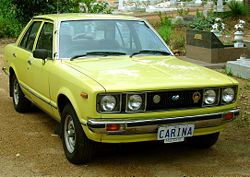 |
|
| Also called | Toyota Carina Toyota Corona Toyota Celica |
|---|---|
| Production | 1980–1982 |
| Assembly | Toyota City, Japan |
| Body style(s) | 4-door sedan |
| Layout | FR |
| Engine(s) | 1.6 L 12T-U I4 1.8 L 13T-U I4 2.0 L I4 |
| Wheelbase | 2500 mm (98.4 in) |
| Length | 4445 mm (175 in) |
| Width | 1645 mm (64.8 in) |
| Height | 1390 mm (54.7 in) |
| Curb weight | 1010 kg (2227 lb) |
Originally launched as the Toyota Celica Camry in January 1980 for the Japanese home market, this model was essentially a second-generation Toyota Carina with updated body-styling and a front-end that resembled a 1978 Toyota Celica XX, known as the Celica Supra in export markets.
The car was based on the rear-wheel drive Celica and was powered by either a 1.6 litre 12T-U engine producing 65 kilowatts (88 hp) JIS and 128 newton metres (94 lb·ft) or a 1.8 litre 13T-U engine producing 70 kilowatts JIS (94 hp) and 147 newton metres (108 lb·ft). Towards the end of its model lifecycle, Toyota introduced a sports version of the Celica Camry equipped with the 16-valve double overhead camshaft 2.0 litre engine from the Celica producing 72 kilowatts JIS (96 hp). This is the most sought-after version of the Celica Camry in the secondhand market today.
Although it has an identical 2500 millimetre (98.4 in) wheelbase to the Celica, the Corona, and the Carina, it is longer than the Carina but shorter than both the Corona and Celica. During its model cycle, over 100,000 units were sold in Japan. The Celica Camry was also exported to a number of markets using the Carina's name, and it replaced the second-generation Carina in these markets.
First generation (SV10) (1982–1986)
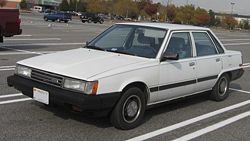 |
|
| Also called | Toyota Vista |
|---|---|
| Production | 1982–1986 |
| Assembly | Toyota City, Japan |
| Body style(s) | 4-door sedan 5-door hatchback |
| Layout | FF |
| Engine(s) | 1.8 L 1S-L I4 1.8 L 1C-TL(C) I4 2.0 L 2S-ELC I4 2.0 L 2C-TLC turbodiesel I4 |
| Transmission(s) | 5-speed manual 4-speed A140E automatic |
| Wheelbase | 2600 mm (102.4 in) |
| Length | 4440 mm (174.8 in) |
| Width | 1690 mm (66.5 in) |
| Height | 1395 mm (54.9 in) |
| Curb weight | 1045 mm (41.1 in) |
In 1982, the Camry became an independent model line, and was sold as a compact four-door sedan and five-door hatchback. There were limited exports, predominantly to right-hand-drive markets. At this point, Camry was positioned above the Carina and Corona, two other mid-sized models made by Toyota. A twin was announced at this point: the Toyota Vista.
The design of the first generation Camry fit well within the box-shaped trends of the early 1980s. Additionally, the vehicle size and available options were characteristic of Japanese-designed cars of the time; the Camry was a compact sedan, with a solid but spartan construction and competed indirectly against larger American counterparts.

In North America, the Camry was available with a 68 kilowatt SAE (92 hp) 2.0 litre 2S-ELC engine, 1.8 litre 1C-TLC or a 55 kilowatt (74 hp) 2.0 litre 2C-TLC turbodiesel engine. Either a four-door sedan or five-door hatchback body style could be specified, and could be purchased with either a five-speed manual transmission or a four-speed A140E automatic. In contrast to the rear-wheel drive Celica Camry, the Toyota Camry was a front-wheel drive vehicle built on an all-new platform. In Australia, only the petrol-fueled hatchback was sold. The United Kingdom, and much of Continental Europe got the sedan and hatchback versions: these were available in 1.8 litre GLi or 2.0 litre GLi trim levels. A 2.0 litre GLD turbodiesel was also offered, but this is rare nowadays.
Second generation (SV20) (1986–1990)
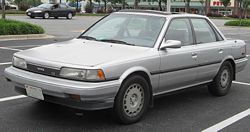 |
|
| Also called | Holden Apollo Toyota Vista |
|---|---|
| Production | 1986–1990 (Japan) 1986–1991 (North America) 1987–1993 (Australia) |
| Assembly | Georgetown, Kentucky Port Melbourne, Victoria, Australia Toyota City, Japan |
| Body style(s) | 4-door sedan 4-door station wagon |
| Layout | Front engine, front-wheel drive / Four-wheel drive |
| Engine(s) | 1.8 L 1S I4 (1987-1989) 2.0 L 3S-FE I4 2.5 L 2VZ-FE V6 |
| Transmission(s) | 5-speed S51 manual 5-speed S53 manual (FF I4) 5-speed E52 manual (V6) 5-speed E56F5 manual (F4) 4-speed A140E automatic 4-speed A540E automatic (V6) 4-speed A540H automatic (F4) |
| Wheelbase | 2600 mm (102.4 in) |
| Length | 4520 mm (178 in) |
| Width | 1690 mm (66.5 in) |
| Height | Sedan: 1374 mm (54.1 in) Wagon: 1384 mm (54.5 in) |
| Curb weight | 1240 kg (2734 lb)–1295 mm (51 in) |
| Related | Lexus ES 250 |
The second generation model debuted in 1986, this time including a station wagon while dropping the hatchback body style. At this point, it was still regarded as a compact car. In 1988, an all-wheel drive system dubbed All-Trac was introduced and a 2.5 litre 118 kilowatt JIS (160 hp) V6 engine were added as options for the first time. The V6 was fuel-injected with 24 valves, and dual overhead camshafts, much like the upgraded 96 kilowatt JIS (130 hp) four-cylinder engine. In Japan there was a GT model using the older 3S-GE engine as used on the Celica. This particular model also had a factory strut brace similar to an AE92 Corolla and rode on the V6 model's 15 inch alloy wheels. This particular model also had an electronic instrument cluster.


In 1987, Toyota Australia began producing these second generation Camrys in Altona, Victoria, Australia. In fact, it was the first Camry ever made outside of Japan. A 1.8 litre four-cylinder engine rated at 64 kilowatts (86 hp) was standard on the base model, while a 2.0 litre four-cylinder rated 88 kilowatts (116 hp) was available on all others. In 1988, a 2.5 litre V6 was introduced. The V6 sat the very top of the range, and was the only model to be imported from Japan. Due to its positioning in the line-up, and the high import duty it attracted, it was very expensive, and only sold in small numbers. In 1989, the 1.8 litre engine was dropped, and was replaced with a carburetted 2.0 litre engine, producing 82 kilowatts (110 hp).
Toyota Motor Manufacturing Kentucky, the first wholly-owned U.S. Toyota plant, began producing Camrys in 1988, where three trim levels of the second generation Camry were made: the unbadged base model, the DX, and the LE. The 2.5 litre engine and Camry chassis was repackaged as the upscale Lexus ES 250. The ES 250 was essentially the Japanese-market Camry hardtop. In 1991, anti-lock brakes became optional on the V6, LE, and station wagon models. These second generation models were extremely popular in the United States and it is not at all uncommon to see examples on American roads, even to this day more than two decades after production.
Third generation (SV30) (1990–1994)
 |
|
| Production | 1990–1994 |
|---|---|
| Assembly | Tsutsumi, Japan |
| Body style(s) | 4-door sedan |
| Layout | Front engine, front-wheel drive / Four-wheel drive |
| Engine(s) | 1.8 L I4 2.0 L I4 2.2 L I4 (turbodiesel 2.0 L V6 2.5 L V6 |
| Width | 1695 mm (66.7 in) |
| Related | Toyota Scepter Toyota Vista V30 |

The third generation SV30 Camry was introduced exclusively to the Japanese market in July 1990. A widened version of this model was also sold in Japan as the Toyota Scepter. The Scepter incorporated unique front- and rear-end styling, with the side doors and many other sheet metal and mechanical components interchangeable between the two cars. Outside of Japan, the Scepter was known as the Camry SXV10. These generation classification are for the Japanese market Camry. The third generation US Camry was introduced from 1992-1996 while the fourth generation was introduced from 1997-2001, the fifth generation camry was from 2002-2006, and lastly the sixth and current generation in the US is from 2007-present. The U.S. Camry is presently in its six generation while the Japanese market version is in its seventh generation.
For the 1991 model year, a four wheel steering version of the JDM Camry was sold with a 2.0 L V6 engine, with the name Toyota Camry V6 PROMINENT 4WS, and chassis code E-VZV31.[4]
An updated model appeared in July 1992. The scope of changes ranged from a new, larger grille and a revised air conditioning unit. At the same time the ZX touring package appeared in place of GT.
A two-door Camry Coupé was added to compete with the Honda Accord Coupé. However, the Camry Coupé was never popular and was dropped in 1997. A two-door Camry would not be reintroduced until 1999, with the Toyota Camry Solara.
There is also a convertible derivative version of the Camry called the Solara from 1994-1997 and later spun off into its own line as the Camry Solara when reintroduced in 1999. However, the Solara development lags behind the sedan by a couple years and the production is scheduled to end in 2008.[5]
Fourth generation (SV40) (1994–1998)
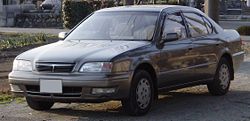 |
|
| Production | 1994–1998 (JDM) |
|---|---|
| Assembly | Tsutsumi, Japan |
| Body style(s) | 4-door sedan |
| Layout | Front engine, front-wheel drive / Four-wheel drive |
| Engine(s) | 1.8 L I4 2.0 L I4 2.2 L I4 (turbodiesel) |
| Length | 4625 mm (182.1 in) |
| Width | 1695 mm (66.7 in) |
| Height | 1410 mm (55.5 in)–1435 mm (56.5 in) |
| Related | Toyota Vista V40 |
The Camry SV40 appeared in July 1994 exclusively for the Japanese market. Engines for the SV40 comprised of a 1.8 litre (4S-FE type) and 2.0 litre (3S-FE type), and a 2.2 litre turbodiesel (3C-T type). At launch only the 2.0 litre model was available in all-wheel drive mode, although afterwards the 2.2 litre turbodiesel could be optioned with this system.
Toyota updated the SV40 in June 1996. In the update anti-lock brakes and dual air bags became standard equipment. After 1998, the Japanese market Camry and international Camry became in-line with each other, with the Toyota Vista taking over the SV30 and SV40 Camry roles.
Fifth generation (SXV20) (1996–2001)
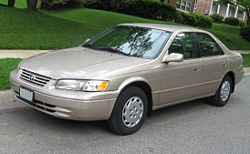 |
|
| Also called | Daihatsu Altis Toyota Vienta |
|---|---|
| Production | 1997–2001 |
| Assembly | Tsutsumi, Japan Georgetown, Kentucky Altona, Victoria, Australia |
| Body style(s) | 4 door sedan 4-door station wagon (non-US) |
| Layout | FF layout |
| Engine(s) | 2.2 L 5S-FE I4 133 hp 3.0 L 1MZ-FE V6 194 hp |
| Transmission(s) | 5-speed manual 4-speed A140E automatic 4-speed A541E automatic |
| Wheelbase | 105.2 inches (2,672 mm) |
| Length | 189.8 inches (4,821 mm) |
| Width | 70.1 inches (1,781 mm) |
| Height | 55.4 inches (1,407 mm) |
| Related | Lexus ES/Toyota Windom Toyota Sienna Lexus RX Toyota Highlander Toyota Camry Solara Toyota Avalon |
With info translated from the entry for Daihatsu Altis in the Japanese Wikipedia :
The fifth generation Camry was launched in Japan in December 1996. It continued as a sedan and station wagon (called the Camry Gracia in Japan), though the latter model was not sold in the United States. This generation was launched in the U.S. for the 1997 model year.
An equivalent model was launched as the Daihatsu Altis, it was only sold in Japan, and its production started from this generation. Tha Altis was introduced March of 2000 as a flagship sedan for Daihatsu as a replacement for the Daihatsu Applause. Not very many Altis are sold in Japan because the typical Daihatsu is priced in the entry level pricing range, and the Altis is priced very similar to the comparable model JDM Toyota Camry. Tha Altis is available with the Toyota 5S-FE 2.2 L 4 cylinder engine. Unlike the Camry, which is available as a sedan or wagon in Japan, the Altis is a sedan only. The name "Altis" is a variation of the word "altitude", implying a "high elevation" status as the top level car for Daihatsu.
In 2000, the sedan models received a mid-model upgrade to the front and rear fascias, but remained otherwise similar to the 1997 to 1999 models. The Japanese Scepter ceased to exist as the Japanese Camrys adopted the 1,795 mm (70.7 in) wide platform.
The Vista began departing from the Camry, remaining 1,700 mm (66.9 in) wide and eventually forming the basis of the growing Corolla. In addition, the Vista's sheetmetal resembled a tall, formal sedan, while the Camry became sleeker. This "split" continues today.
The Lexus ES 300 was again built from the Windom, which uses the Camry chassis.
A coupe was added in 1999, and then a convertible form in 2000. In contrast to the coupe from the third generation Camrys, the new two-door cars were given a separate nameplate Camry Solara, or simply Solara. They were also a significant styling departure from the sedan. The Solara was available in SE and SLE trims, corresponding roughly to the sedan's LE and XLE trims.
In the United States, the Camry SE was dropped and the base model was renamed the CE for the 1997 model year. Both the LE(Limited Edition) and the XLE trims were carried over from the previous generation. All trim levels were available with either the 2.2 L I4 or the 3.0 L V6 engine except the Solara SLE, which was only available with the V6. The LE-based Collector Edition was new for 2001 model year.
Power was increased slightly to 133 hp SAE (99 kW) for the 5S-FE 2.2 L I4 and 194 hp SAE (145 kW) for the 1MZ-FE V6. Manual transmissions (model: S51) were only available on the CE trim level, LE V6, and any Solara model.
For the General Export Market, the Camry was offered as 2.2 GLX and 3.0 V6 Grande.
This was the first Camry to be sold as a Daihatsu; the Daihatsu Altis was identical to the export version of the Camry.
The Camry V6 was again on Car and Driver magazine's Ten Best list for 1997.
Tuners have successfully swapped a 2JZ-GTE inline 6 cylinder engine into this generation of Camry.
A more upmarket version of Camry Gracia wagon was sold in Japan as Mark II Qualis. It had no relation to Mark II sedan besides front and rear optics, which simulated those of Mark II X100. Mark II Qualis was also available in 3.0G version, with 1MZ-FE V6 engine, not available in JDM Camrys.
Australia
In Australia, unlike the previous generation, the Camry name was also applied to the V6 variants, while the Vienta V6 range was revised as the "upmarket" models. The line-up of 4-cylinder Camry models consisted of the CSI, Conquest and CSX models (automatic transmission only); all three variants were available in sedan or wagon. The Camry V6 models consisted of CSI and Conquest, with the wagon models only available in automatic transmission. The Camry V6 Touring Series sedan model was launched in March 1999. The Vienta line up consisted of VXI and Grande sedan models and the VXI wagon. The VXI model was basically a V6-powered version of the 4-cylinder Camry CSX model.
In September 2000, the revised Camry was launched. The Vienta V6 range was discontinued due to the launch of the Avalon sedan in July 2000 and two new models were added to the Camry range: the top-of-the-range Azura V6 sedan and the Touring Series V6 wagon, both of which were available with an automatic transmission only. Towards the end of the model run, the limited edition Intrigue and Advantage sedans were launched.
Middle East
In Middle East, the Camry was offered in three different trims, the low end XLI plus the better equipped GLI that both carry a four cylinder engine, the third is the V6 Grande trim which carries the 1MZ-FE engine plus a lot of other options. The Middle Eastern Camry also was offered as a wagon, with the GLI trim only.
Sixth generation (SXV30) (2002–2006)
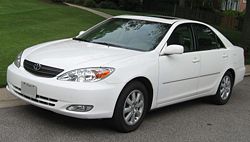 |
|
| Also called | Daihatsu Altis |
|---|---|
| Production | 2002–2006 |
| Assembly | Tsutumi, Japan Georgetown, Kentucky Altona, Victoria, Australia Chachoengsao, Thailand Santa Rosa, Laguna, Philippines Shah Alam, Malaysia Taipei, Taiwan |
| Body style(s) | 4-door sedan |
| Layout | FF layout |
| Engine(s) | 2.4 L 2AZ-FE I4, 157 hp 3.0 L 1MZ-FE V6, 192 hp 3.0 L 1MZ-FE VVT-i V6, 210 hp 3.3 L 3MZ-FE VVT-i V6 SE (2004-2006), 225 hp |
| Transmission(s) | 5-speed manual 4-speed U241E automatic 5-speed U151E automatic 4-speed U140E automatic 5-speed U250E automatic |
| Wheelbase | 2720 mm (107.1 in) |
| Length | 4805 mm (189.2 in) |
| Width | 1795 mm (70.7 in) |
| Height | 1490 mm (58.7 in) (2005-06) 1470 mm (57.9 in) (2002-04 LE) 1480 mm (58.3 in) (2002-04 SE & XLE) |
| Related | Lexus ES/Toyota Windom Toyota Sienna Lexus RX Toyota Highlander Toyota Camry Solara Toyota Avalon |
In September 2001, the Toyota Camry was released as a larger sedan (taking styling cues from the successful Vitz, Corolla, and Solara) only, but without a station wagon for the first time. Due to station wagons losing popularity to minivans and crossover SUVs, the Camry wagon was replaced by the Toyota Sienna minivan (in North America only) and the Toyota Highlander SUV, both vehicles utilizing the Camry's platform.
The front end of the car was relatively short, leaving a great deal of the length to the cabin, a technique adopted by compact cars. In contrast to the fairly squat fifth generation Camry, the sixth generation was a decidedly tall vehicle. It was 2.5 in (64 mm) taller and had a 2 in (51 mm) longer wheelbase than the previous model.
In the United States, the basic CE model was dropped for 2002 and the SE sport model was reintroduced. Both the LE and SE models were available with a manual transmission when equipped with the four-cylinder engine. Any model could be equipped with a V6 or an automatic transmission, although the manual transmission was not available on V6 models.[6] The Camry XLE had an engine that was equipped with a drive-by-wire throttle.
Until the 2003 model year, the Camry Solara remained on the sixth generation chassis, and received only minor styling upgrades to the front and rear ends. However, the Solara did receive the same 2.4 L 2AZ-FE VVT-i I4 engine that was available on the Camry sedan.
The second generation Camry Solara was introduced in 2003 as a 2004 model. Again, styling from the Camry was radically different, taking design cues from the Lexus SC430. The 2.4 L VVT-i engine was still offered, however, a new 3.3 L VVT-i V6 was optional. The Solara also received the new 5-speed automatic transmission the sedan was given. In addition to the SE and SLE trims, a new SE Sport was offered. Unlike the first generation Solara, the SLE trim could be had with the four-cylinder engine.[7]
In late 2004, the 2005 Camry was introduced with new upgrades such as a chrome grille (though the SE had a sportier grille), new headlight and taillight designs, redesigned front bumper, and new wheels. A new base trim level was added, which was priced lower than the Camry LE. Interior upgrades to the Camry included a rear center head restraint, a storage bin in the door, Optitron gauges, steering wheel-mounted audio controls standard for all trim levels, and standard leather seating on V6-powered XLEs. A 5-speed automatic transmission was now available on both the V6 and I4 engines; the I4 engine receiving the new transmission for the 2005 model year.
Daihatsu continued with its twin Altis model for the Japanese market. The second generation Altis was introduced September 2001, and was available with the 2AZ-FE 2.4 L 4 cylinder engine. Visually, the Altis is very similar to the JDM Toyota Camry with the 4 cylinder engine.
Australia and New Zealand
In Australia and New Zealand, the 2002 to 2006 Camry is available in five different trims: the Altise, Ateva, Sportivo, Grande (2004 onwards), and Azura. The Altise, Ateva, and Sportivo are available with either the 2.4 L four cylinder or the 3.0 L V6 engine, whilst the Grande and Azura were only available with the V6. Only the Altise and Sportivo models could be fitted with a manual transmission — all other models are equipped with a four-speed automatic transmission. In 2003, the V6-powered Altise Sport model was introduced, which is basically the Altise model with the sports suspension that was fitted on the Sportivo and Azura models and was available in manual and automatic trasmission. The Australian and New Zealand Camry Sportivo corresponds roughly to the American Camry SE.
The Australian and New Zealand models were significantly different from the other Camry models around the world and had around 77% locally developed components to suit Australian and New Zealand roads and driving conditions. The brakes, body panels (which would only fit on the Australian made body and chassis), headlights, seats, radio antenna and suspension were all locally developed after 10,000 km of extensive testing in New Zealand under the supervision of Toyota engineers. Power output on the Altise Sport, V6 Sportivo and Azura models was 145 kW (194 hp) compared with the 141 kW (189 hp) of the standard V6 models due to a high-flow rear muffler.
When the revised range was launched in Australia and New Zealand in September 2004, the Grande model was reintroduced which, together with the Azura model, were the top-of-the-range models. The Grande however was fitted with the standard suspension rather than the sports suspension as fitted on the Azura model. The Grande and Azura models have Satellite Navigation (GPS) as standard equipment, and were the first Toyota models in Australia to be fitted with the new Toyota Link system. The Toyota Link system is a state-of-the-art satellite and mobile SMS GSM communications system that gives the driver access to roadside assistance and emergency help via the electrochromatic rear view mirror. In August 2005 the Altise Sport model was reintroduced (V6 auto only) together with Altise Limited (four-cylinder and V6) that has additional features. The Ateva model had an interior upgrade to leather trim and rear passenger air conditioning vents. The Altise was repositioned as a fleet model and manual transmission was no longer available on V6 Sportivo models from January 2006 production. Automatic Camrys in Australia still used the dated four-speed rather than the new five-speed introduced in the US across the range. The new 3.3-liter engine that replaced the 3.0 in the American V6 also did not come to Australia.
A number of milestones were achieved with this generation's Camry in Australia. The one millionth Camry (Black Azura) built in Australia and 10 millionth Camry worldwide rolled off the production line at Altona in September 2004. In May 2006 Toyota Australia exported the 500,000th Camry to New Zealand, in recognition of the relationship between Toyota Australia and Toyota New Zealand. More than 90% of Australian Camry exports are left-hand drive vehicles to Middle East countries including Saudi Arabia, Kuwait, Bahrain, Oman, Qatar, and the United Arab Emirates. The overseas demand for the Australian-made Camry is still running at record levels, despite the release of an all-new model in August 2006. The current Australian-made Camry remains one of the top-selling passenger vehicles in Saudi Arabia. In the Middle East, the fifth generation Camry is available in 4 trim levels: XLi, GLi, Touring, and Grande V6.
A high performance concept of the Toyota Camry, named the Toyota Camry TS-01 was shown at the 2005 Melbourne International Motor Show. This concept vehicle had significant performance and visual upgrades from the production Toyota Camry and was one of the concept vehicles designed what is now TRD Australia.
East and Southeast Asia
The Camry in Taiwan and Malaysia of this generation looked very similar to other versions, but the front end had a "thicker" grille and larger, all-white, differently shaped headlights.[8] The reverse lights were moved onto the trunk and were somewhat similar to the lights on a second generation Avalon's trunk.[9] The older models from 2002-2003 had tail lights with a white streak across them,[10] while models 2004 and later did not.[11]
In the Philippines, the fifth generation Camry was initially introduced with 2.0 and 2.4-liter engines, with four-speed automatics and no manual option. Compared to the US version, this had a different front end design (grille and headlights), as well as inner taillight garnishes. The facelifted version saw off the 2.0 and introduced the 3.0-liter V6 with five-speed automatic along with new colors and wheel design.
Seventh generation (SXV40) (2007–present)
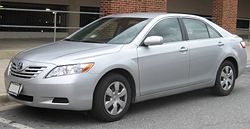 |
|
| Also called | Daihatsu Altis |
|---|---|
| Production | 2007–present |
| Assembly | Altona, Victoria, Australia Chachoengsao, Thailand (Aurion) Georgetown, Kentucky, United States Guangzhou, China (Aurion) Lafayette, Indiana, United States Toyota, Aichi, Japan Saint Petersburg, Russia Santa Rosa, Laguna, Philippines (Aurion) Shah Alam, Malaysia (Aurion) Taipei, Taiwan |
| Body style(s) | 4-door sedan |
| Layout | FF layout |
| Engine(s) | 2.4 L 2AZ-FE I4 (118 kW (158 hp)) 2.4 L 2AZ-FXE I4 (Hybrid) (140 kW (187 hp)) 3.5 L 2GR-FE V6 (200 kW (270 hp)) |
| Transmission(s) | 5-speed manual 6-speed manual 5-speed U250E automatic 6-speed U660E automatic P311 CVT (Hybrid) |
| Wheelbase | 2,776 mm (109.3 in) |
| Length | 4,805 mm (189.2 in) |
| Width | 1,820 mm (72 in) |
| Height | 1,470 mm (58 in) |
| Curb weight | 1,489 kg (3,280 lb) |
| Related | Lexus ES/Toyota Windom Lexus RX Toyota Aurion Toyota Camry Solara Toyota Highlander Toyota Sienna Toyota Camry Hybrid |
The seventh generation Camry was introduced at the 2006 North American International Auto Show alongside a hybrid version and went on sale in March 2006 as a 2007 model. The 2007 Camry was significantly redesigned and featured a 2-inch longer wheelbase. Overall length and passenger volume remained equal to the predecessor, while trunk space decreased by about 1.5 cu-ft.
Power came from a choice of four- and six-cylinder engines. The 2.4 L 4-cylinder engine was carried over from the past generation and produced 158 hp and 161 ft·lb. It came with a 5-speed manual or 5-speed automatic. The 3.5 L V6 engine in contrast came with a 6-speed automatic only and produced 268 hp and 248 ft·lb.[12]
The Camry came factory-equipped with frontal airbags, upper body-protecting side-impact airbags for the front seats, head-protecting side air curtains for front and rear seats, and a driver's knee airbag. Other standard safety features included a tire pressure monitoring system, ABS, Brake Assist, and EBD.[13] As a result of this comprehensive safety equipment, the Camry fared excellently in crash tests.
The IIHS awarded the Camry sedan a rating of Good on both "Frontal Offset" and "Side Impact" crash tests.[14]
The National Highway Traffic Safety Administration (NHTSA) Crash Test Ratings:[15][16]
Frontal Impact: ![]()
Side Impact: ![]()
Rollover: ![]()
Sales in the United States, the primary market for the Camry, significantly increased in the year following release. Quarterly sales totalled a record 46,630 vehicles for second quarter of the American 2007 model year.[17]
The seventh generation model Toyota Camry received a four-star safety rating as a result of Australasian New Car Assessment Program (ANCAP) testing.[18]
Consumer Reports 2007 Annual Car Reliability Survey gave the V6 version of the Toyota Camry a "below average" rating, thus removing the V6 Camry from Consumer Reports' "Recommended" list. This rating does not apply to the four cylinder and hybrid versions, which continued to be recommended. However, these problems have been corrected, and the V6 version has improved to "average".[19] Consumers of Reviewcars.com awarded 2007 Toyota Camry with "Car of the Year" distinction.[20]
Seventh generation Toyota Camrys sold in some countries in Asia and the Middle East have different exterior body parts and a similar interior to the Camry depicted.
International production
Toyota Camrys are produced at Georgetown, Kentucky, USA, Aichi, Japan, Melbourne, Australia, St. Petersburg, Russia, and in China (for the Chinese market only). The Camry sold in China shares the front and rear design used for the Australian 6-cylinder 'Aurion'.
On April 20, 2007, Camry manufacturing began at Subaru of Indiana Automotive, Inc. in Lafayette, Indiana USA, with intended production of about 100,000 units per year.
A Camry manufactured in Japan is denoted with a VIN starting with "J", as well as a small hatch on the passenger's side of the front bumper containing equipment that is compatible with Japanese towing systems; US-made models are denoted with a VIN starting with "4".
Daihatsu continued with its twin Altis model for the Japanese market. The third generation Altis was introduced January 2006, and continued to be available with the 2AZ-FE 2.4 L 4 cylinder engine. Visually, the Altis is very similar to the JDM Toyota Camry with the 4 cylinder engine.
Camry Hybrid
The seventh-generation Toyota Camry is the first generation in which the Camry has been available as a gasoline/electric hybrid. The Camry Hybrid utilizes Toyota’s second generation Hybrid Synergy Drive and contains a 4-cylinder engine with 147 hp (110 kW) in conjunction with a 40 hp (30 kW) electric motor for a combined output of 187 hp (139 kW).[21] The Camry is currently the third Toyota model to be offered as a hybrid, the others being the Toyota Prius and the Toyota Highlander.
Camry Hybrids were initially built solely in Japan, though the majority of production has since shifted to Toyota’s Georgetown, Kentucky plant, which is projected to produce 45,000 of the vehicles per year. In June 2008, Toyota Motor Corporation has announced that the Camry Hybrid will also be built in a Thailand plant in 2009 and in Melbourne in 2010 with an annual production capacity of 9,000 and 10,000 respectively.
United States Environmental Protection Agency fuel economy estimates for the 2007 Toyota Camry Hybrid are 40 mpg-US (5.9 L/100 km/48 mpg-imp) (City) and 38 mpg-US (6.2 L/100 km/46 mpg-imp) (Highway).[21] EPA’s revised method of estimating fuel economy for 2008 and subsequent model years, which now considers the effects of air conditioning, rapid acceleration and cold temperatures, estimates 33 mpg-US (7.1 L/100 km/40 mpg-imp) (City) and 34 mpg-US (6.9 L/100 km/41 mpg-imp) (Highway).[22]
Australia and New Zealand
The seventh generation Camry went on sale in Australia and New Zealand on August 20, 2006. For the first time in 18 years, it is marketed in those countries as a four cylinder model only. The simplified model range consists of the 'Altise', 'Sportivo', 'Ateva', and 'Grande' (in ascending order in terms of price). The Grande model was the first Australian-made Camry to be fitted with rain-sensing wipers, stability control, traction control and Bluetooth connectivity. Stability control was not available across the range until August 2007, where it became standard on all variants. In May 2008, the Grande variant received a change in specifications to the same set of alloy wheels as the 'Sportivo' variant, as opposed to the 'Grande' variant previously. It is worth noting that before the change, the "Grande" model had the same wheels as the "Ateva" model. Also, released in May 2008, was the Ateva L. It included extra features such as a rear lip spoiler, the same alloys as the "Sportivo" variant and leather seats.
Although Camry models are only offered with four cylinder engines, the Toyota Aurion, which has side windows, door panels, windscreen and roof panels identical to those in the Camry, is offered with V6 engines.[23]
Toyota Australia produces the Camry for both domestic and export markets such as the UAE and the Middle East in Altona, Victoria. There have plans to negotiate a deal with Toyota to begin the manufacture of right hand drive Toyota Camry hybrids at Altona.[24]
The Toyota Camry, as of 2008, is Australia's best selling locally made vehicle, when taking into account all sales, both domestic and exports.[25]
Canada
In 2009 model year, which is sold starting in spring 2008, the cost for entire line was lowered by up to $2500.[26] With such a price drop, the Canada price is still 30% higher than the one in the US for an identical model, due to the higher charges for freight and delivery.
The engines are a 2.4-litre inline four-cylinder in the LE and SE, and a 3.5-litre V6 in the LE V6, SE V6 and XLE V6. The 2.4-litre comes with a five-speed automatic in the LE and a five-speed manual in the SE, which can also be optioned with the automatic; reviewers consider the 2.4-litre engine somewhat underpowered.[27] All V6 Camrys use a six-speed automatic with manual shift mode. The Hybrid is powered by the 2.4-litre four-cylinder with hybrid electric system fitted with a continuously variable transmission (CVT).
The XLE comes only as a V6 model and is the higher trim level compared to the base LE. The Camry Hybrid is very similar to the XLE, save for its Synergy Drive powertrain and engine. The SE (Sport Edition), priced between the LE and XLE, differs from the rest of the Camry trims, having 17-inch alloy rims, a sport-tuned suspension, a three-spoke steering wheel, lip spoiler, side skirts, sport-style grille, and fog lamps. All other Camrys come with 16-inch alloy rims, while the 4-cylinder LE has 16-inch steel wheels standard though alloy wheels are available as part of the Touring package.[28]
While Vehicle Stability Control and Traction Control were initially exclusive to V6 cars for the 2008 generation, these features are now offered on every Camry model, save for the 4-cylinder LE which has these as part of the Convenience package. The moonroof is optional on the LE, SE, and LE-V6, while standard on the other Camry models.
There is a new Navigation package, which is built on top of SE V6 Leather and JBL package, including DVD-based navigation system with 7-inch LCD screen.
South East Asia and China
The Camry sold in the ASEANations is essentially a rebadged version of Toyota Aurion sold in Australia. However, the interior is carried over from the USDM/JDM Camrys, with some difference. The 2 liter variant of the engine based on the 1AZ-FE is a 2.0 L is also available. The output is 108 kW (147 PS/145 hp) at 6000 rpm with 190 N·m (140 lb·ft) of torque at 4000 rpm.
In Malaysia, the 2.0 L models are available in two trim packages: the 2.0 E and 2.0 G. The 2.4 variant is also in Malaysia, utilizing the 2AZ-FE engine model. The output of this 2.4V model is 123 kW (167 PS/165 hp) at 6000 rpm with 224 N·m (165 lb·ft) of torque at 4000 rpm. Toyota Camry LE V6 engine, CD DVD Players 5 tires and 3 drivers.
The Camry in the Philippines offers three grades: the base G, offering a l4 2.4 2AZ-FE engine producing 167 bhp (125 kW/169 PS), mated to a 5-speed gate-type automatic transmission, has 2 SRS airbags, has fabric seats and has a foot-type parking brake. The 2.4 V is almost the same as the G variant, however, its has a 4-spoke steering wheel with wood grain, 2 SRS airbags, and has a leather-wrapped wood grain with chrome shift lever and knob. The 3.5 Q is the top-of-the-line segment, offering a 3.5 2GR-FE V6, 24V, DOHC and dual VVT-i. It is mated to a 6-speed gate-type automatic transmission, adaptive front lighting system, automatic rain sensor, dual exhaust tail pipe, tri-color/Optitron with multi-information display, 2 SRS front airbags, side SRS airbags, and a push start system. All of the variants has an integrated type / tuner/ in-dash 6 CD changer / MP3 / WMA. All of the variants also use a foot-type parking brake, and welcomes the driver whenever the ignition is set to "ON", displaying on the central console "Welcome to Camry". All of the variants has 4 front speakers and 2 rear speakers.
References
- ↑ "Wired 2 The World". Retrieved on 2007-11-15.
- ↑ [1]
- ↑ "2007 Toyota Camry SE Road Test". Car and Driver.
- ↑ http://www.japan-partner.com/Auto/5811/Toyota/Camry/car-for-sale.html
- ↑ "2008 Toyota Camry Review". US News.
- ↑ "2002 Toyota Camry Review & Specs". JB car pages. Retrieved on 2008-08-10.
- ↑ "2004 Toyota Camry, Solara Review". JB car pages. Retrieved on 2008-06-22.
- ↑ "2005 Toyota Camry Picture". Toyota Taiwan.
- ↑ "2005 Toyota Camry Pictures (Taiwanese Version)".
- ↑ "2002 Toyota Camry Picture (Taiwanese Version)".
- ↑ "2004 Toyota Camry Pictures (Taiwanese Version)".
- ↑ "2007 Toyota Camry Specs". JB car pages. Retrieved on 2008-08-10.
- ↑ "2007 Toyota Camry Review". JB car pages. Retrieved on 2008-08-10.
- ↑ "2007 Toyota Camry Crash Test Ratings". Insurance Institute for Highway Safety. Retrieved on 2008-06-22.
- ↑ "NCAP ratings for 2007 Passenger Cars (2007 Toyota Camry 4-DR. w/SAB)".
- ↑ "NCAP ratings for 2007 Passenger Cars (2007 Toyota Camry Hybrid 4-DR. w/SAB)".
- ↑ "The Auto Channel".
- ↑ "2006 Toyota Camry Ateva". Transport Accident Commission. Retrieved on 2007-09-09.
- ↑ "Consumer Reports Cars Blog: Toyota". Retrieved on 2007-11-03.
- ↑ "ReviewCars.com Announces 2007 Car of the Year: Toyota Camry". Retrieved on 2008-8-15.
- ↑ 21.0 21.1 "2007 Toyota Camry Hybrid Specs". JB car pages. Retrieved on 2008-08-10.
- ↑ EPA 2008 Toyota Camry Hybrid
- ↑ "2007 Toyota Aurion Sportivo ZR6 Road Test". CarAdvice.com.au Pty Ltd (2007-02-22). Retrieved on 2007-08-31.
- ↑ "Toyota Australia closes in on Camry Hybrid". Drive.com.au Pty Ltd (2008-05-05). Retrieved on 2008-06-02.
- ↑ "Camry is the best-selling Australian made car". Toyota.com.au (2008-05-27). Retrieved on 2008-06-02.
- ↑ "Toyota Canada drops price of 2009 Camry". Canadian Driver.
- ↑ [2]
- ↑ [3]
- ^ "Toyota Camry Reviews and Specs", JB car pages. Retrieved on 2008-06-22.
|
|||||||||||||||||
| — Toyota road car timeline, North American market, 1980s–present | ||||||||||||||||||||||||||||||
|---|---|---|---|---|---|---|---|---|---|---|---|---|---|---|---|---|---|---|---|---|---|---|---|---|---|---|---|---|---|---|
| Type | 1980s | 1990s | 2000s | |||||||||||||||||||||||||||
| Model year | 0 | 1 | 2 | 3 | 4 | 5 | 6 | 7 | 8 | 9 | 0 | 1 | 2 | 3 | 4 | 5 | 6 | 7 | 8 | 9 | 0 | 1 | 2 | 3 | 4 | 5 | 6 | 7 | 8 | 9 |
| Subcompact | Tercel | Tercel | Tercel | Tercel | Tercel | Echo | Yaris | |||||||||||||||||||||||
| Starlet | Corolla FX | Paseo | Paseo | |||||||||||||||||||||||||||
| Corolla | Corolla | Corolla | ||||||||||||||||||||||||||||
| Compact | Corolla | Corolla | Corolla | Corolla | ||||||||||||||||||||||||||
| Matrix | Matrix | |||||||||||||||||||||||||||||
| Corona | Camry | Camry | Prius | |||||||||||||||||||||||||||
| Mid-size | Prius | |||||||||||||||||||||||||||||
| Camry | Camry | Camry | Camry | |||||||||||||||||||||||||||
| Camry Solara | Camry Solara | |||||||||||||||||||||||||||||
| Venza | ||||||||||||||||||||||||||||||
| Full-size | Cressida | Cressida | Cressida | Cressida | Avalon | Avalon | Avalon | |||||||||||||||||||||||
| Sport compact | Corolla GT-S | |||||||||||||||||||||||||||||
| Celica | Celica | Celica | Celica | Celica | Celica | |||||||||||||||||||||||||
| Sports | Celica Supra | Celica Supra | Supra | Supra | ||||||||||||||||||||||||||
| MR2 | MR2 | MR2 Spyder | ||||||||||||||||||||||||||||